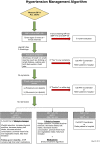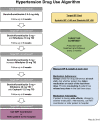Hypertension testing and treatment in Uganda and Kenya through the SEARCH study: An implementation fidelity and outcome evaluation
- PMID: 31940346
- PMCID: PMC6961918
- DOI: 10.1371/journal.pone.0222801
Hypertension testing and treatment in Uganda and Kenya through the SEARCH study: An implementation fidelity and outcome evaluation
Abstract
Background: Hypertension (HTN) is the single leading risk factor for human mortality worldwide, and more prevalent in sub-Saharan Africa than any other region [1]-although resources for HTN screening, treatment, and control are few. Most regional pilot studies to leverage HIV programs for HTN control have achieved blood pressure control in half of participants or fewer [2,3,4]. But this control gap may be due to inconsistent delivery of services, rather than ineffective underlying interventions.
Methods: We sought to evaluate the consistency of HTN program delivery within the SEARCH study (NCT01864603) among 95,000 adults in 32 rural communities in Uganda and Kenya from 2013-2016. To achieve this objective, we designed and performed a fidelity evaluation of the step-by-step process (cascade) of HTN care within SEARCH, calculating rates of HTN screening, linkage to care, and follow-up care. We evaluated SEARCH's assessment of each participant's HTN status against measured blood pressure and HTN history.
Findings: SEARCH completed blood pressure screens on 91% of participants. SEARCH HTN screening was 91% sensitive and over 99% specific for HTN relative to measured blood pressure and patient history. 92% of participants screened HTN+ received clinic appointments, and 42% of persons with HTN linked to subsequent care. At follow-up, 82% of SEARCH clinic participants received blood pressure checks; 75% received medication appropriate for their blood pressure; 66% remained in care; and 46% had normal blood pressure at their most recent visit.
Conclusion: The SEARCH study's consistency in delivering screening and treatment services for HTN was generally high, but SEARCH could improve effectiveness in linking patients to care and achieving HTN control. Its model for implementing population-scale HTN testing and care through an existing HIV test-and-treat program-and protocol for evaluating the intervention's stepwise fidelity and care outcomes-may be adapted, strengthened, and scaled up for use across multiple resource-limited settings.
Conflict of interest statement
DJH declares recent support from Teva Pharmaceuticals (https://www.tevapharm.com) for research unrelated to this manuscript; as noted above, DH and MRK report non-financial support from this research from Gilead Pharmaceuticals (https://www.gilead.com).
Figures




Similar articles
-
Hypertension control in integrated HIV and chronic disease clinics in Uganda in the SEARCH study.BMC Public Health. 2019 May 6;19(1):511. doi: 10.1186/s12889-019-6838-6. BMC Public Health. 2019. PMID: 31060545 Free PMC article. Clinical Trial.
-
Effect of a patient-centered hypertension delivery strategy on all-cause mortality: Secondary analysis of SEARCH, a community-randomized trial in rural Kenya and Uganda.PLoS Med. 2021 Sep 20;18(9):e1003803. doi: 10.1371/journal.pmed.1003803. eCollection 2021 Sep. PLoS Med. 2021. PMID: 34543267 Free PMC article. Clinical Trial.
-
Integrated Hypertension and HIV Care Cascades in an HIV Treatment Program in Eastern Uganda: A Retrospective Cohort Study.J Acquir Immune Defic Syndr. 2019 Aug 15;81(5):552-561. doi: 10.1097/QAI.0000000000002067. J Acquir Immune Defic Syndr. 2019. PMID: 31045649 Free PMC article.
-
Diagnosis, Evaluation, and Management of High Blood Pressure in Children and Adolescents.Pediatrics. 2018 Sep;142(3):e20182096. doi: 10.1542/peds.2018-2096. Epub 2018 Aug 20. Pediatrics. 2018. PMID: 30126937
-
Reaching 90-90-90 in rural communities in East Africa: lessons from the Sustainable East Africa Research in Community Health Trial.Curr Opin HIV AIDS. 2019 Nov;14(6):449-454. doi: 10.1097/COH.0000000000000585. Curr Opin HIV AIDS. 2019. PMID: 31589172 Free PMC article. Review.
Cited by
-
Hypertension screening, prevalence, treatment, and control at a large private hospital in Kampala, Uganda: A retrospective analysis.PLOS Glob Public Health. 2022 May 10;2(5):e0000386. doi: 10.1371/journal.pgph.0000386. eCollection 2022. PLOS Glob Public Health. 2022. PMID: 36962239 Free PMC article.
-
Adapting a mobile TB screening unit to provide integrated screening services and linkage to primary care.Public Health Action. 2024 Dec 1;14(4):169-174. doi: 10.5588/pha.24.0025. eCollection 2024 Dec. Public Health Action. 2024. PMID: 39618835 Free PMC article.
-
Leveraging HIV Care Infrastructures for Integrated Chronic Disease and Pandemic Management in Sub-Saharan Africa.Int J Environ Res Public Health. 2021 Oct 13;18(20):10751. doi: 10.3390/ijerph182010751. Int J Environ Res Public Health. 2021. PMID: 34682492 Free PMC article.
-
Health behaviours and beliefs among Malawian adults taking antihypertensive medication and antiretroviral therapy: A qualitative study.Glob Public Health. 2022 May;17(5):688-699. doi: 10.1080/17441692.2021.1874468. Epub 2021 Jan 20. Glob Public Health. 2022. PMID: 33471610 Free PMC article.
-
Implementing screening for hypertension in archetypal HIV primary care: a mixed-methods assessment.BMC Health Serv Res. 2022 Aug 15;22(1):1041. doi: 10.1186/s12913-022-08362-y. BMC Health Serv Res. 2022. PMID: 35971141 Free PMC article.
References
-
- World Health Organization. Global Health Risks: Mortality and Burden of Disease Attributable to Selected Major Risks. World Health Organization; 2009.
-
- Ogedegbe G, Plange-Rhule J, Gyamfi J, Chaplin W, Ntim M, Apusiga K, et al. Health insurance coverage with or without a nurse-led task shifting strategy for hypertension control: A pragmatic cluster randomized trial in Ghana. PLoS medicine. 2018. May 1;15(5):e1002561 10.1371/journal.pmed.1002561 - DOI - PMC - PubMed
-
- Mendis S, Johnston SC, Fan W, Oladapo O, Cameron A, Faramawi MF. Cardiovascular risk management and its impact on hypertension control in primary care in low-resource settings: a cluster-randomized trial. Bulletin of the World Health Organization 2010; 88(6): 412–9. 10.2471/BLT.08.062364 - DOI - PMC - PubMed
-
- World Health Organization. Global health estimates 2014 summary tables: deaths by cause, age and sex, by WHO region, 2000–2012. World Health Organization; 2014.

